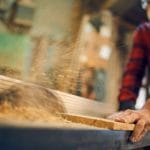Parquet flooring has been popular for many years. It is frequently found in older houses as it was used by wealthy families in years gone by. Today it is increasingly popular although one of the most expensive flooring options.
Of course, if you choose a supplier of quality parquet flooring Sydney, you’ll find that the flooring outlasts other types of flooring materials. This makes it a cheaper option in the long term.
The great thing about parquet flooring is that it’s made from real wood. This means that it is stained, scuffed, or otherwise damage you are usually able to sand the floor to remove the issue and leave it looking like new. This is one of the reasons it lasts for such a long time.
However, being wood, it is understandable to ask whether it is affected by water. Odd spills that are not cleaned up promptly can cause stains to develop. Of greater concern is persistent leaks, especially if they go unnoticed. The water can soak into the parquet flooring and cause it to rot over time You can’t repair rotten wood, only replace it.
The simple solution is to waterproof your flooring to prevent this from being an issue. The good news is that it is possible to waterproof your parquet flooring.
Your Choice of Waterproofing
There are two main choices when it comes to waterproofing your parquet flooring. You can choose a water-based lacquer or an oil-based sealer. Both are viable and offer great protection for your floor.
In general, water-based lacquer is the better option as it is more resistant to water than oil.
Applying The Waterproofing
It’s important to note that we’re talking about being able to walk across the parquet flooring with wet feet and without damaging the surface. This can be done. In contrast, creating a wooden floor that can be used in a wet room is unlikely.
You’ll need to sand your floor first. This will allow you to remove any scuffs and damage to it, creating a high-quality finish. Use an orbital sander and go over the entire room to ensure the floor remains even.
It is important to ensure all parquet blocks have adhered properly first.
You can then clean the floor, making sure all the dust is cleared away and the floor is ready for its sealant.
As mentioned, it’s best to use a water-based sealant. You’ll want to follow the instructions given and give your floor at least three coats of lacquer, allowing it to dry properly between coats. Don’t forget to check the floor is perfectly clean before applying the next coat, or you’ll end up with bubbles in the lacquer. That’s not a good finish!
Once finished you’ll have a floor that is capable of withstanding wet footprints and spills without damage. You should clean it regularly with a brush and then a damp mop and you can add additional layers of lacquer when required.





